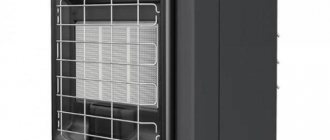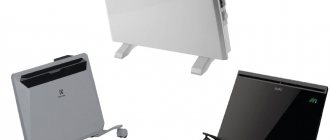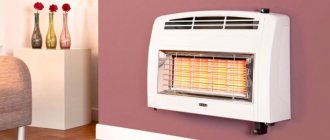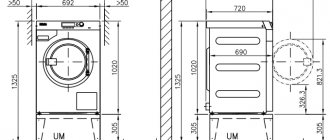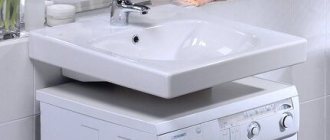| Place | Name | Characteristics in the rating |
| Top 10 Best Bathroom Heaters |
| 1 | REDMOND SkyHeat 7002S | Convenient control via smartphone |
| 2 | Ballu BEC/EZER-2000 | Effective combination of price and quality |
| 3 | Electrolux ECH/AS-1500 MR | Best build quality. Long warranty |
| 4 | Xiaomi Mi Smart Space Heater S KRDNQ03ZM | The best smart infrared heater with clothes dryer |
| 5 | Ballu BIH-AP4-1.0 | Compact and slim design. Local heating |
| 6 | Hintek IW-07 | Excellent splash protection |
| 7 | Veito Blade | Modern technologies, new materials |
| 8 | Noirot Spot E-5 Plus 1500 | The most functional device |
| 9 | Timberk TCH AR7 1000 | Best cost IR heater |
| 10 | TESY CN 03 150 MIS | Freeze, overheat and tip-over protection |
Many of us are accustomed to the fact that bathrooms are heated using heated towel rails or central heating radiators. However, sometimes other types of devices are installed as an alternative or additional means. They have a completely different principle of operation, and therefore differ in design and technological solutions. Such equipment is characterized by compact dimensions, the ability to withstand temperature changes, high humidity, and become a harmonious element of the interior.
When choosing the ideal heater for a particular case, you should consider:
- ratio of room area and model power;
- how quickly the device heats up/cools down;
- the material from which the device is made. It must have anti-corrosion properties, good thermal conductivity, and be safe;
- placement method (wall-mounted, floor-mounted, etc.);
- efficiency of work;
- availability of additional features (thermostat, zone heating of the bathroom, shutdown when overheating, etc.);
- product design.
Requirements for bathroom heaters
The operation of bathrooms and baths, due to the purpose of these premises, is characterized by the presence of the following common factors:
- high humidity;
- frequent direct contact of equipment with water and steam;
- compactness of the room.
Based on this, requirements are imposed on bathroom equipment, including heating equipment, non-compliance with which precludes the possibility of operating these units in premises of this type. Let's look at these requirements in more detail.
Safety. High indoor humidity increases the risk of electric shock from contact with electrical equipment if its wiring shorts to the frame. Due to the fact that a person may be naked in the bathroom, the likelihood of injury from electricity in such a situation increases even more.
It follows from this that special attention should be paid to the insulation and grounding of electrical equipment, the condition of wiring in bathrooms, and sockets should be installed in a waterproof design
The lack of clothing on a person also increases the risk of burns from body contact with the excessively hot body of the heating device or its heating element. Therefore, heaters in the bathroom should be located in places that exclude contact with the human body, or be equipped with protective covers, or have a safe temperature value for the heat exchanger (case).
Moisture protection. The design of bathroom heating devices must be designed for contact with splashes, steam and high humidity so that the heater does not fail prematurely under the influence of these factors.
In addition, the materials used to make the heating device should not be afraid of water or high air humidity. Heater parts made from materials susceptible to corrosion are coated with a protective paint and varnish composition that is resistant to heat and moisture.
Compactness. Bathrooms are rarely spacious, so bulky heaters are not suitable for them - they take up a lot of space and again increase the risk of getting burned in a cramped room. Therefore, the bathroom heater must be compact and selected for a specific installation location.
Sufficient power. Despite the required compactness of the heating device, the power of the heater should be sufficient for a comfortable stay of a person without clothes and heating the bathroom finishing. The small dimensions of the room simplify this task, however, according to the temperature standards in rooms set out in GOST R 51617-2000 “Housing and communal services”, the temperature in the bathroom should not be lower than 25 degrees, and this is by 5-9 degrees. exceeds the corresponding required indicator for other premises.
Hygiene and aesthetics. A bathroom or bathhouse is a room that has high sanitary and hygienic requirements, so not all types of heaters are suitable for heating these rooms. The use of, for example, liquid fuel heat guns in bathrooms is not permitted due to incomplete combustion of fuel in these devices.
The aesthetics of bathroom heaters should also be at a fairly high level - the psychological state of a person largely depends on this factor, since in this room the residents should be in the mood for relaxation.
Water convectors: efficient and spectacular
Water-type convectors are modern devices that are an excellent alternative to standard radiators. The devices are successfully used in autonomous heating systems of private houses and apartments, as well as in centralized heating networks. Water convectors are reliable, economical and durable, their efficiency is about 95%.
Types of water appliances
Water convector devices are an ideal solution for rooms with a large glass area. Depending on the model, a water convector can be either an independent heating unit or a source of additional heating.
Thanks to various equipment form factors, the heating issue can be solved not only efficiently, but also effectively.
Water convectors are:
- floor;
- wall-mounted;
- baseboards;
- intra-field;
- built-in
All of them take up minimal space, and in the case of hidden installation, they even save usable space. Installation in the wall, floor, steps, or under furniture allows you to save such valuable square meters and provide comfortable heating. In-floor devices with drainage drainage can be successfully used in rooms with swimming pools, greenhouses, winter gardens, etc.
At the individual request of the customer, the body of the water convector can be painted in almost any color, and also decorated to resemble wood or other materials
A variety of designs - from laconic classic to bright modern - makes it easy to fit the units into any interior.
Features of various equipment modifications
Water wall convectors are a steel body with a perforated grille located on top, which houses a copper-aluminum heat exchanger. The devices are mounted using a special mounting kit, which is necessarily included in their factory package.
Wall convectors are an excellent choice for rooms that require fast and efficient heating and have enough free space for installation on the wall. This is the most successful solution for children's rooms and bedrooms. They are not suitable for heating solid glazing that extends into the floor.
Floor-standing water convectors are usually installed in rooms with low window sills. It is also possible to install them near panoramic windows if, due to the low height of the screed, it is not possible to install an in-floor unit. In addition to the housing with a heat exchanger, such devices are structurally supplemented with a steel supporting base.
Some manufacturers offer water convectors with air conditioning functions. Thanks to this 2-in-1 equipment, you can heat the room during cold weather, and cool it in the summer
Such convectors somewhat clutter up the space, however, they fit perfectly into rooms with modern interiors in the loft, modern, hi-tech, and avant-garde styles.
Skirting water heating devices are practical and compact. The low thermal intensity of such convectors allows them to be mounted directly next to furniture and various decorative elements. This gives a huge advantage in terms of organizing space.
Structures built into the floor are used to cut off cold air flows coming from windows. The units can effectively solve the problem of condensation on large window glazing (“crying windows”). Built into the floor level, they take up no space at all and do not interfere with enjoying the panoramic view.
After installation, in-floor convectors are covered with a special grille that plays a protective and decorative role.
Types of heating devices
Today on sale you can find a large assortment of heating devices that meet all conditions; all that remains is to make the right choice.
Heating batteries
These can be either heated towel rails or ordinary radiators, which are installed in rooms and kitchens:
- Heated towel rail with water operating principle. Ideal for equipping small spaces. They are unlikely to be able to heat a large space. A water heated towel rail will only be relevant when there is hot water in the house.
- An electric heated towel rail is obviously a convenient device, but it requires significant financial investment.
- Aluminum radiators have high heat transfer. When installing such batteries, be sure to install gas outlet tubes, since aluminum emits a small amount of gas when in contact with hot water.
- Cast iron batteries are a good budget option that also has a long service life. Such devices are resistant to mechanical damage. The disadvantages include quite a lot of weight and low heat transfer.
- Steel radiators have high heat transfer. Their installation is simple, and their service life is very long.
- Bimetallic structures are the most expensive option for heating equipment.
Oil radiator
Undoubtedly, an oil radiator can be found in almost every home or office. This type of heating device has won the trust of buyers due to its mobility and relatively low price. The body of the device is metal, inside it there is an electric coil. The rest of the space of the heater is filled with mineral oil (for more details, see the article about the design features of oil heaters).
When you turn on the device, the coil heats up, the heat from it is transferred to the oil, which boils over time. And this, in turn, heats the entire body. This is how the room is heated.
Most of these devices consist of sections, and the more there are, the higher the heat transfer.
Radiators are equipped with a regulator with which you can control the degree of heating of the device.
Advantages of oil heating devices:
- high degree of heating;
- complete security;
- mobility (easy to move from room to room due to the presence of wheels);
- silent operation;
- do not burn oxygen, are especially relevant if they are placed in a small bathroom;
- presence of a regulator.
Flaws:
- slow heating compared to other devices;
- some models may emit an odor;
- require a certain amount of space in the room.
Infrared heater
This heater is an economical heating device that is placed on the wall or ceiling.
The infrared heater is a heat-emitting plate and a quartz emitter. The plate can heat up to 260 degrees.
The principle of its operation is as follows: the device heats the air to a certain temperature, after which it automatically turns off. When the temperature begins to decrease, the heater turns on automatically (for more details, see the article on the operating principle of a heater with infrared radiation).
A plus is that an infrared heater saves space, which residents so desperately need when designing a bathroom. And also the fact that it warms up not only the air, but also the walls, floor and interior items, the emanating heat from which helps to maintain comfort in the bathroom longer.
The infrared rays of the device can be directed to any point in the room, which makes it possible to heat only that part of the room where it is necessary.
The advantages of this type of heating equipment are:
- security;
- reliability;
- efficiency;
- presence of a thermostat;
- opportunities to save space, since the device does not take up space on the floor;
- small sizes;
- large selection of models.
The only downside worth noting is that the cost of an infrared heater cannot be called low. But if you spend money once, the device will definitely pay for itself in the future.
Electric convectors
Convector heaters are most often used to insulate office premises, and sometimes apartments. They have a power of up to 2500 watts, which is enough to heat a room of 25 sq.m. The shape of the device is rectangular, inside it there is a heating coil that warms up the incoming cold air. Electric convectors are either hung on the wall or installed on the floor. Maximum efficiency can be achieved by installing them as close to the floor as possible.
Convectors have undoubted advantages:
- silent operation;
- safety;
- mobility;
- quick heating of the room;
- ability to maintain temperature for a long time;
- moisture-resistant housing;
- the ability to connect several devices;
- economical waste of electricity;
- stylish design.
Installing radiators in the bathroom
Staircase radiators are installed in most bathrooms. They consist of horizontally located tubes connecting vertically located crossbars. This design allows you to hang wet towels, underwear or clothes on the radiator.
These are practical models that look good on the wall. However, if the bars are too close together, dust can become a problem. You can also install a panel radiator in the bathroom, which, due to its relatively small heat exchange surface, maintains it for a long time.
It doesn't take up too much space in the room, but not everyone may like the simple design. An alternative to ladder and panel radiators are horizontal radiators, also made of pipes (thin or thick). They cause more intense air circulation in the room, which has a positive effect on heating efficiency.
Convectors for the bathroom
Zhanna RybnikovaWhat is a micathermic heater and the principle of its operation, technical data, i.e. power and design Micathermic heaters (micathermic radiators), infrared heaters In addition to traditional oil heaters, more economical and efficient ones, in terms of heating, have recently been increasingly used...
Elizaveta Znamenskaya
How to get rid of dampness in the bathroom, I live on the first floor. Make a forced hood. The hood goes without saying. Without it, how will you dry your clothes? Cover all the walls with tiles and the ceiling with atepan. And God bless her with dampness. The main thing is ventilation. If this is a comfortable apartment, then the entire wall is made of floor slabs. And there are all the channels there. They... Insulate the floor or make heated floors, and also make sure that the hood is good
Albert Taborsky
Question for heating engineers and competent male owners. You've got a good idea! Unfortunately, not new. Factory booster blocks (fans) have been used for a long time, though on convectors (for example, Yaga. By the way, a heater is a heat exchanger with a fan. The heat transfer of the device will increase... Coolers. They give a sense of this, I know for sure, but they are noisy. So it’s better to have larger sections, bimetal radiator Leningradka and the temperature of the batteries must correspond to the temperature outside
Lydia Ushakova
What kind of home heating do you have and what problems have you encountered? The house has a heated area of 180 sq. m, 2 floors, basement. Water CO with forced circulation and fed from the water supply system. Three boilers – diesel Proterm Bizon, t/t+electrics Karakan 20TE. 5 heating circuits - 1st and 2nd floors, Gas. no problems Tashkent all year round In my village house, the stove is IT! Well, if you’re too lazy to heat it, then I turn on the NOBO YF 2 KW. good thing. If there was main gas, we would have AOGV, our friends at the dacha have it, it’s also a good thing. But I think that a fireplace in a country house...
Yaroslav Apraksin
How to heat a bathroom? Hairdryer I connected the heated towel rail to the hot water supply and at the moment there is no talk of any dampness. well, of course + forced ventilation Warm floor, electric snake for anyone Actually, dampness is corrected by ventilation, and not simply warmed up. The main cause of dampness is non-functional ventilation. Restore the ventilation and everything will be fine no matter what kind of heated towel rail and without heated floors. If you start to intensively heat the bathroom when the ventilation is not working, you will get...
Denis Andreychikov
In a private house, replacing batteries with pipes, which heats more and is more efficient. Special sources contain calculations and comparisons of various heating radiators. The most effective, oddly enough, are considered to be registers, that is, pipes D 75 mm. And you can always disguise them. Based on the reference literature, it is worse than being heated by pipes that encircle the entire house NO! A correctly calculated heating system and high-quality installation using modern radiators is the only solution!
Boris Lukoshkov
Is it possible to leave convectors on around the clock? Convector Its performance characteristics are similar to an oil radiator. They are used in apartments, offices, cottages, houses, and can also be used as the main heating system. Suitable for any premises. All…
Lyudmila Zhadnova
How much do you pay per month for this? We have a warm house - a fireplace in the house and a solid fuel boiler (no gas). The house is one-story, 130 square meters. But for the whole winter it comes out to about $600, no more. Taking into account the fact that for me personally +25 is cool) Fireplace + electric convectors 100sq. m approximately 2.5 t. We have a fireplace, gas, and a pellet stove; we pay one hundred euros for gas per month, no less. despite the fact that there is a stove in the hallway and a fireplace in the living room, the radiators turn on in the morning, if I set the thermostat to 18 degrees, the apartment is large and the length of the bedrooms is dubilo...
Pavel Dengin
What is better to install an additional heated towel rail (electric) or heated floor in the bathroom? For warmth)) You are unlikely to be able to dry things on a warm floor. This is more of a convenience than a necessity. Of course, it’s easier to install a heated towel rail, it will be warmer in the bathroom, but not much, this is from personal experience. The floor will still be cold. A warm floor is better: the bathroom will be warmer and walking on a warm floor will be more pleasant. Again, from personal experience - I have...
Raisa Tretyakova
Why doesn't the convector heat the room above 15 degrees? Bathroom above 23? If the capacity of the heating devices (power reserve) allows heating, then it will heat up to 40 degrees. Incorrect selection of convector. Actually, a radiator is better - unlike a convector, it has a radiant radiator, 30 is its power, but in fact, don’t open the doors often; mine is more powerful. Natasha correctly wrote that it is weak. Until you insulate the windows, there will be no point.
Arthur Zhdanko
Which radiators are better? What batteries should I buy? Italian aluminum or cast iron? Depends on the water, if the water is clean, then you can use Italian, if there is an impurity, it will clog them up in no time. Take cast iron into your apartment, because it “digests” any water well and high pressure, when the system is checked before the heating season. For the home you can use cast iron, but aluminum is better, just install a good filter so that...
Anna Kharkina
Does a water heated floor really heat more efficiently than a radiator? No! Heated floors have no efficiency. The radiator is more efficient in this regard. To heat with floors effectively, you need to make a special heating system and thermal protection for the house. Heated floors work effectively at low temperatures, like... Very good. This is the only heating in my friend's house. No radiators or other crap. It heats more efficiently in terms of comfort; in terms of energy consumption, the effect is zero compared to radiators. But, this does not mean that underfloor heating is no good. In general, decide whether you need heated floors or not, and that’s it! If you do...
Marina Salomatova
Ventilation duct. question Listen to the stove maker, why does he go to work drunk, the ventilation should be pulled out, bring a burning match, if it pulls out flames or smoke, send him away and don’t let Durik go home anymore. What kind of supply ventilation is that in a production room? The hood should work in any case! It’s easy to check, place a piece of notebook paper on the grille – it should hold. If not, you can complain...
Oksana Kobeleva
Which radiators are better or heated floors? Has anyone had any experience and if possible, tell me the company in St. Petersburg. Radiators (or convectors) are heating devices designed to transfer thermal energy that compensates for heat loss in the room. Warm floors are a gadget that relates exclusively to comfort and are usually not even taken into account when calculating the heat balance... Heated floors on the entire first floor. very good and convenient. and no batteries are needed.
Igor Armeev
How much kW does a heated floor consume, and how much does it cost? The couple here calculated and advised you. Look here 2-3 kilowatts per day. He doesn’t constantly consume energy. It heats up and then turns off. It’s difficult to calculate since ideal conditions for both installation and operation are needed, this is about the same as how a car eats. But you will calculate it when you start using it, but here you can turn it on or not,
Vyacheslav Apokin
Bath under the window. What to do with the battery? Hang nearby Radiators are recommended under the window opening, not in order to prevent fogging of the windows, but as a thermal curtain that prevents heat loss through the window; the more chambers the window package has, the less loss through it. Therefore, fogging you in... It all depends on the glass unit. We install a 2-3 chamber energy-saving one and don’t be sad: The picture shows my bathroom. Heated floor and heated towel rail not near the window. It’s basically impossible to get rid of condensation COMPLETELY, or it will be cold in the bathroom...
Irina Mikhina
What is a micathermic heater? Micathermic heaters (micathermic radiators), infrared heaters In addition to traditional oil heaters, more economical and efficient ones have recently been increasingly used…
Alexey Sukin
What are air heaters in bathrooms called? Precisely designed for work in conditions of high humidity! It's not clear from the description. Here are several options: 1. Electric heated floors 2. Heated towel rails - water heated towel rails are connected to the hot water supply system and electric ones 3. Infrared heaters 4. Electric convectors... You don’t have to heat the bathroom, it’s cheaper to lie in the bathtub - it’s warm)
Veronica Vorilina
For those who live in an apartment, is it cold at home? We have a heater that saves heat in the bathroom and toilet. Every fall we prepare for winter: we insulate windows, doors, and balconies. Therefore, in the most severe frost we are warm. Maybe you can insulate your windows too? Of these, there are usually 24. It’s very warm here, although there are severe frosts outside. North. It’s even hot here, I ventilate it all the time. We wear light clothes very warmly. Normal central heating.
Lilia Glebovskaya
Cottage 160 sq.m., I want to install incr heating - film on the ceilings. Who did it and how does it work? Is there enough heat? Firstly, not IF, but IR. I first installed it in my own room. I survived last frosty winter well. Now I have installed such heating in all rooms. The only drawback is that the air heats up last, so it is possible... IF rays heat objects, not the air. Therefore, the head will always be hot, and this is harmful to the brain. This will not add heat. In addition, one should take into account the colossal difference between the climates of Russia and the Euro-liberals, and the Americans too. In England, castles were heated...
Popular types of heating devices
The modern market of heating devices offers a fairly wide selection of devices designed for heating bathrooms. These include:
- metal water heating radiators;
- infrared heaters;
- convective-infrared heaters;
- oil instruments;
- electric convectors;
- fan heaters;
- cast iron radiators.
To have an idea of the different types, you can consider the characteristics of the most popular models.
Water heating radiators
Popular with users. Such devices have replaced old, cast-iron radiators. Connecting a heated towel rail to a hot water riser is easy.
The advantages of such devices include:
- long service life;
- low price;
- a light weight;
- simplified installation process.
The connection diagram of the device is quite simple; any master can handle connecting the heater. In addition, this device does not consume electricity, unlike other heaters.
Important!
Connecting a heated towel rail to a boiler is also possible; this is especially true for residents of houses with no hot water supply system.
Panel heaters
It is not the air in the room that warms, but the walls and floor. The installation location of the device is the ceiling.
Such heaters do not take up room space; they are advisable to use in rooms with a lack of free space. In addition, such a heater meets the most stringent safety requirements.
The design of such a device is complex; it can function fully in rooms even with extreme humidity levels.
Also interesting: Mirror ceiling - a spectacular design in the bathroom
The advantage is energy savings - the beams of the device, depending on the need, can be directed in any direction.
The disadvantage is the high price. Bathroom heating mats work on this principle.
Infrared models
The heating element in convective-infrared modular heaters is an element made from a special threshold with a nichrome thread inside.
This device can be hung on the wall; by the way, it does not spoil the appearance of the room at all. The power of the device is adjusted using a thermostat.
You can place the heater not only on the wall, but also on the ceiling, and the device will warm the room equally well.
The heating element is a ceramic panel, which is a radiator.
Once heated, it emits infrared waves. They do not come into contact with air, but affect surrounding objects. Such devices can be used in conditions of high humidity.
The undoubted advantage is that they do not produce unpleasant noise, unlike fan heaters, and act as a source of lighting at night.
When choosing a heating device, you need to start not only from taste preferences. It is important to compare the power of the device with the dimensions of the heated room. A summary table will help you understand these parameters:
| Area (sq.m) | Required power of the device to ensure optimal heating (W); |
| 5-6 | 500 |
| 7-9 | 750 |
| 10-12 | 1000 |
| 12-14 | 1250 |
| 15-17 | 1500 |
| 18-19 | 1750 |
| 20-23 | 2000 |
The use of insufficiently powerful appliances in large bathrooms is unjustified; this will lead to energy costs, but the heat generated will not be enough to fully warm up the room.
Fact!
The internal part of the heater warms up to 150°C, but the body temperature does not exceed 60°C.
Oil appliances
They are one of the most popular devices. An electric spiral, which is placed inside the device, heats up the oil, due to the boiling of which the body is heated, and after which the air in the room warms up.
Presented in a metal case with a ribbed structure. They are installed using special anchors that come with the device.
Advice!
Such fittings may not be of very high quality, so it is better to purchase a set of anchors separately. The heating element of such a device is a heating element, and the coolant is oil.
The design is resistant to corrosion, as the surface is covered with enamel. The thermostat protects the device from overheating, which also affects energy consumption.
The device turns off automatically after the air in the room warms up to the required temperature. An oil radiator can be used to dry clothes.
The advantages also include:
- high maximum temperature;
- operational safety;
- no noise;
- automatic shutdown when overheating;
- wheels for ease of movement.
Also interesting: Exhibition of domestic construction and finishing materials
Preference should be given to devices with a built-in air ionizer, because oil heaters dry out the air in the room.
You should not purchase cheap models, because during operation they can emit an unpleasant odor.
Electric convectors
Used for space heating. The device consists of a metal body and an internal heating coil. The air passes through the heating part and warms up.
It is worth noting that the efficiency of such heaters improves if such devices are located below.
When choosing heaters of this type, you should pay attention to:
- devices with a ceramic heating element do not burn air;
- for use in the bathroom, preference should be given to devices with high protection against moisture;
- the advantage will be the presence of wheels for free movement of the device;
- room heating speed.
The disadvantage of devices made according to this scheme is that they have a built-in fan, which often acts as a source of excess noise.
Fan heaters
They are the simplest heating devices, and many users choose them for heating bathrooms. The power of such devices is quite high.
They are quite compact, so they can be installed on the floor or other flat surface.
A fan heater is a simple device consisting of a plastic housing, a fan and a heating coil.
Among the advantages are:
- low cost;
- ease of use;
- device mobility;
- ability to quickly warm up the room;
- ease of operation;
- small sizes;
- modern appearance.
The device has certain disadvantages, for example, it makes annoying noise and emits an unpleasant odor.
